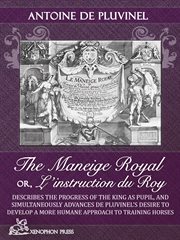Nonfiction
eBook
Details
PUBLISHED
DESCRIPTION
1 online resource
ISBN/ISSN
LANGUAGE
NOTES
Le Maneige Royal takes the form of a dialogue between master and pupil. The Master, de Pluvinel and the Pupil, the Dauphin. This work describes not only the progress of the royal pupil but also de Pluvinel's desire to develop a more humane approach to training horses. His bits and spurs are considerably modified when compared to those of his predecessors. In this respect, the influence of de Pluvinel is most clearly reflected, in terms of English masters, in the difference between the last considerable master before his day-Blundeville-and the first after him-The Duke of Newcastle. Much barbarity had been shed in the interval which was filled by de Pluvinel's teaching. Among other things, de Pluvinel was the first riding master to describe all of the High School movements and aids, and is believed to have been the first to use pillars for training horses. The original publication of the work was not without incident. During a visit to Holland, de Pluvinel met a certain Crispin de Pas, an artist whom he engaged as drawing-master for his academy. He then asked de Pas to make the engravings for his manuscript, L'Instruction du Roy. However, before the book could be published, de Pluvinel died. He had been engaged in revising it at the time of his death. After de Pluvinel's death, de Pas obtained an unrevised copy of the manuscript from a servant named Peyrol. Then in 1623, de Pas, published this unrevised and unfinished manuscript, with his own engravings with the title, Le Maneige Royal. All of this was done without the consent of de Pluvinel's literary executor, René Menou de Charnizay who had official custody of the revised manuscript. Eventually, after many difficulties, René Menou de Charnizay rewrote the text of Le Maneige Royal in 1625 and later obtained the plates of the de Pas engravings-which incidentally are wonderful examples not only of a horse's position but also of the fashions of the day. Thus, in 1626, the book was produced in its present form. Le Maneige Royal is an extremely important equestrian classic, which is also of vast artistic and historical interest and merit. Xenophon Press is pleased to make this work available once more to the English speaking world. Unquestionably one of the most important books ever written about the art of horsemanship, de Pluvinel's treatise is complete with the celebrated illustrations by Crispin de Pas. Translated from the 1926 edition, this is the foundation stone of any collection of equestrian literature. Pluvinel's "Le Maneige Royal" was published posthumously in 1625 in its complete form with beautiful engravings by the Flemish engraver Crispijn van de Passe II, edited by Pluvinel's friend Menou de Charnizay, under its definitive name "L'Instruction du Roy en l'exercice de monter a cheval" ("Teaching the King how to ride a horse"). Pluvinel is perhaps most well-known for his kind, humane training methods. Pluvinel used praise, careful use of aids, and softer bits (simple curb bits) to get the horse to work with him. He is also known for his extensive use of the pillars in his training of collection and levade. Additionally, he employed the two-track movements, such as shoulder-in, and voltes to supple the horse. His theories include that the horse must take pleasure in work, due to gentle, understanding riding, and that such a horse will move much more gracefully if he enjoys being ridden. Hardback, clothbound, silver embossed, stamped cover comes shrink-wrapped, gift quality. Translated by Hilda Nelson
Mode of access: World Wide Web







